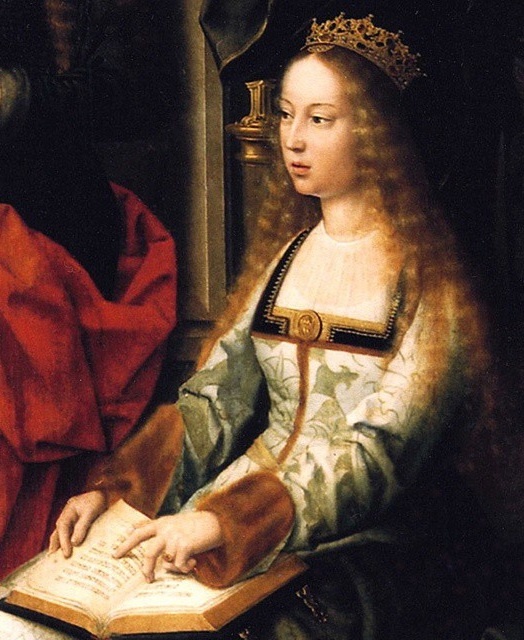
Isabella I of Castile, in the painting Virgen de la mosca. The Collegiate church of Santa María la Mayor. Public Domain.
While Castile did not have a law banning women from succeeding the throne of Castile, Isabella (1451 – 1504) — one of the medieval period’s most famous queens — did not grow up expecting to rule her country of birth. She had two brothers, an older half-brother called Henry and a younger brother called Alfonso, who both preceded her. Through a combination of chance and her own determination, she came to rule Castile for many years.
Isabella’s father died when she was just three years old and her older half-brother Henry took the throne as Henry IV. He discarded his first wife (due to the couple’s childlessness) and married Juana of Portugal. The couple had a daughter, but rumors spread that Henry was impotent and that child’s father was actually Beltran de la Cueva. This led Juana to have the nickname “la Beltraneja.” It seems Henry must have suspected the rumors might be true because when Alfonso died, he named 17-year-old Isabella as his heir instead his young daughter.
Isabella was determined nothing would jeopardize her claim to the throne. She rejected suitors from England and France and knew there was only one man for her: Ferdinand of Aragon. When they both came into their inheritance, their marriage would unify Spain. When Henry IV died, Isabella held her coronation without waiting for Ferdinand. When Ferdinand said “I have never heard of a queen who usurped this male privilege,” he didn’t realize that this was a sign of things to come. Isabella fully intended to rule with Ferdinand as her king consort. Ferdinand inherited Aragon from his father, John II, a year later, but his lands were much smaller and less wealthy than their neighboring Castile. This caused issues with the couple, but Isabella did her best to consult her husband and to agree with him in public when she could; she always had the final say and always did what she thought was right for Castile. Despite these fractious moments, the couple did work together effectively for Spain, and had 5 children.
Isabella was a religious fanatic and worked for 10 years of her reign to reclaim Granada back from the Moors. Initially she was generous with the peace terms and allowed the Moors to practice their religion, however when her confessor, Francisco, Cardinal Jimenez de Cisneros convinced her that forced conversion was the way forward, she agreed. The Moors had the “choice” to convert to Catholicism or be exiled from Spain. Meanwhile the Jews were given three months to leave Spain and in 1492, 170,000 Jews left Spain, moving primarily to Italy and the Ottoman Empire.
Isabella was also determined to add colonial possessions and wealth to Castile and decided to sponsor Christopher Columbus in his attempts to go to the New World. These new lands brought vast wealth to Castile. It was a gamble as Portugal had already rejected Columbus’s proposal, but it is one that paid off.
Isabella showed the world, and her husband, that a woman could rule effectively. She left a mixed legacy of extreme religious intolerance and the first European exploration of South America. Through her daughter Juana, Spain ended up being inherited by her grandson Charles, who also inherited the Hapsburg Empire from his father’s side, inadvertently creating the biggest European empire of its time. She was also the grandmother of England’s first queen, Mary I, through her daughter, Catherine of Aragon.
